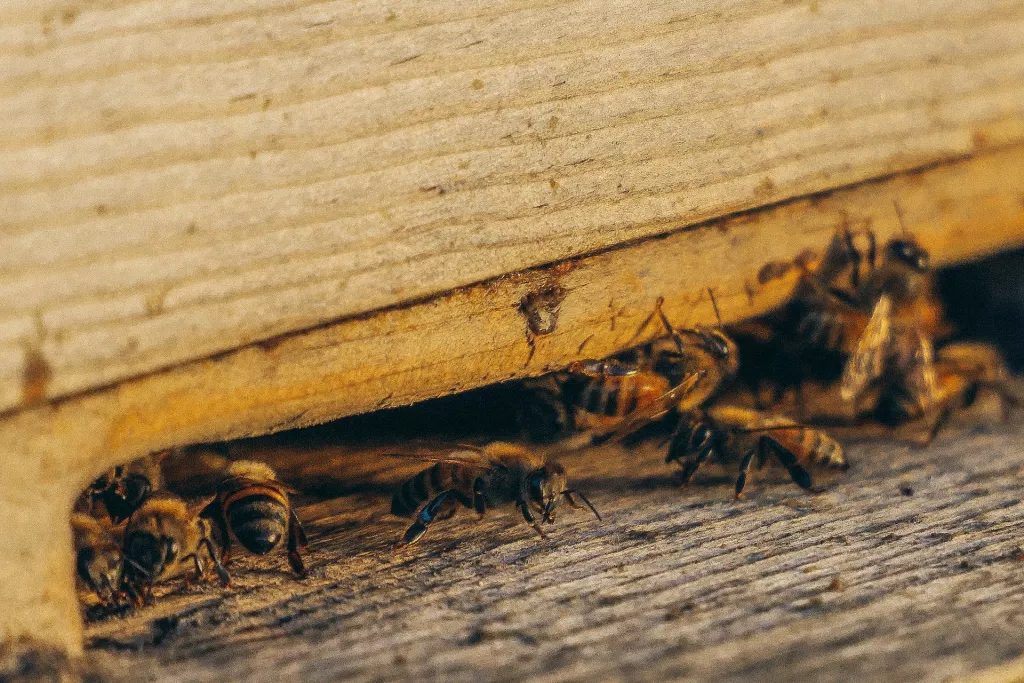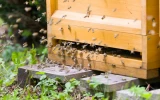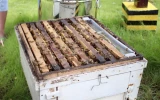The Correct Beehive Entrance Hole Size: This Big
Bees can be surprisingly particular about the places they choose to use as a hive locations. The entrance to their hive seems to be one of the most essential factors, but many beekeepers might wonder, what’s the correct beehive entrance size?
The natural entrance wild bees prefer is about 1 ½ - 2 ½ square inches, or 10–15 square centimeters, according to bee expert Tom Seeley. This prevents predators from getting into the hive and allows the bees to quickly move in and out of the hive.
Bees can be particular about where they live, so as a beekeeper, it’s your duty to make them feel at home and to consider how large beehive entrances should be. Let's dive into more details below.
Summary
- The correct beehive entrance size should be around 1 ½ - 2 ½ square inches, or 10–15 square diameters.
- The hive’s entrance plays several important roles in keeping the colony healthy and alive.
- A hive entrance needs at least 2 feet in front and 3 feet on the sides for bees to freely move in and out of the hive.
- The ideal location for the beehive entrance should be facing southeast or east.

On this page:
The Correct Beehive Entrance Size
Wild bees can adapt to any sort of entrance in their hives. However, in a managed beehive, the rules are different. A beekeeper has to consider the width, location, and number of entrances and how the bees can get in and out of the hive.
Bees are weird but fascinating insects. They’re incredibly adaptable to their environment and excel at building colonies and making honey. According to bee expert Tom Seely, bees prefer to have small entrances rather than larger ones. To be exact, bees prefer an entrance hole of about 1 ½ to 2 ½ square inches, or 10–15 square centimeters.
If the hive’s entrance is too big, the bees might decide to move out and build a new hive.
What Size of Holes Bees Fit Through
Bees are capable of fitting through surprisingly small holes. The size of the hole that a bee can fit through depends on the species of bee, but most bees can fit through holes as small as 5–6 millimeters in diameter. This is because bees have a flexible exoskeleton and can compress their bodies to squeeze through even the smallest of openings.

Keep in mind that larger bees such as bumblebees may struggle to fit through small entrances. Additionally, a group of bees may have trouble entering a small opening if there's a bottleneck or if the opening is blocked in some way.
When it comes to beehives, many beekeepers often choose to install entrance reducers to control the size of the opening and prevent robbers or other pests from entering the hive.
Purpose of hive entrances
Thermo-regulation
The entrance allows the colony to thermo-regulate their hive during hot or cold weather. The entrance provides a barrier that protects the internally occupied space from the impact of the external environment. To survive cold or hot weather, the in-hive temperature should be kept at an average of 35 degrees Celsius.
Reduce moisture
During winter, the entrance can minimize the buildup of moisture within the hive. Moisture can be a serious threat to the colony, especially when it’s in a passive environment, such as in the winter or on windy days.
The entrance also provides a path for the bees to carry out waste and moisture, which helps to prevent the buildup of excess moisture that could harm the colony. Additionally, it also helps to reduce the risk of mold or mildew growth, which can cause health problems for the bees.
Staging area
The beehive entrance can act as a staging point where essential resources like pollen, water, and nectar are transferred into the colony. The entrance also allows bees to gather and coordinate their activities. For example, bees can quickly respond to changes in the environment or threats to the colony.
Effective defenses
Hive entrances are also effective as the first line of defense against robber bees or other pests. Invaders will have a tougher time stealing the honey when there’s only one point of entry. Bees stationed at the entrance are responsible for guarding the hive against intruders and other threats.
A well-positioned and well-maintained entrance can help reduce the risk of theft or attack from predators, ensuring the health and survival of the colony.
How Much Space Should Be in Front of a Beehive
The recommended amount of space varies depending on the type of beehive, but typically it should be at least two feet in front and three feet on either side. This provides enough room for the bees to move around freely and access food sources without being crowded or blocked by other obstacles.
Additionally, it also allows beekeepers to inspect their hives safely, and provides a buffer zone between them and any potential predators.
Having too little space in front of the hive can cause the bees to cluster at the entrance, reducing the airflow and creating an ideal environment for disease and pests.
On the other hand, too much space can increase exposure to the elements and make it difficult for the bees to defend the entrance. Maintaining the recommended 3 feet of open space in front of the hive entrance is key to a healthy and thriving bee colony.
The Correct Location of the Beehive Entrance
The beehive entrance needs to be positioned that lets bees easily enter and exit the hive, while also providing protection from predators. Depending on your area, it should be facing southeast or east and can bask in the morning sunlight and has protection from harsh winds.
The ideal entrance should be located at least 3 feet off the ground and away from direct sunlight or wind. It should also face away from prevailing winds so that bees don’t get blown back into their hive when they try to leave. The entrance should also be far enough from the ground to prevent predators from reaching the bees, but low enough for easy access.

Finally, it should have a landing board or ramp for easy access by the bees. It's recommended to have at least 9 inches of space in front of the entrance for the bees to fly in and out without obstruction. By following these guidelines, beekeepers can help ensure that their hives remain healthy and productive for years to come.
Langstroth Hive Entrance Size
The standard size for a Langstroth hive entrance is 16 inches wide and 1 1/2 inches tall. This entrance size has been found to provide a good balance between accessibility and protection. It's important to keep the entrance clear of debris to ensure easy movement and prevent blockages.
In cold weather, it's recommended to reduce the entrance size to help regulate the temperature inside the hive. A well-sized and positioned entrance is an essential component of a thriving Langstroth hive.
Upper Entrance Beehive
An upper entrance beehive is a variation of the traditional beehive design that features an entrance located at the top of the hive. This type of entrance is becoming increasingly popular among beekeepers because it has a number of benefits.
Firstly, the top entrance helps to regulate the temperature of the hive, as it allows hot air to escape more easily. Secondly, the top entrance makes it easier for beekeepers to extract honey during harvest season. Thirdly, the top entrances make it easier for foraging bees to access the supers of the hive directly.
Finally, the upper entrance can also help to reduce moisture levels within the hive, which can help to keep the bees healthy and prevent disease.

